#pschent crown
Explore tagged Tumblr posts
Text
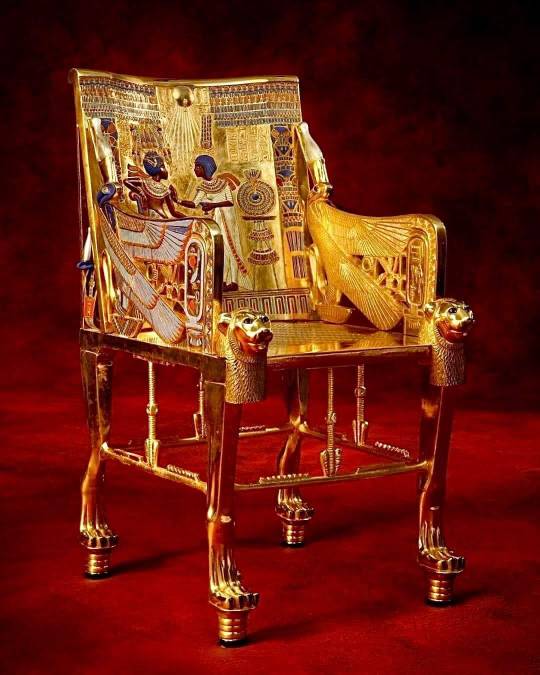
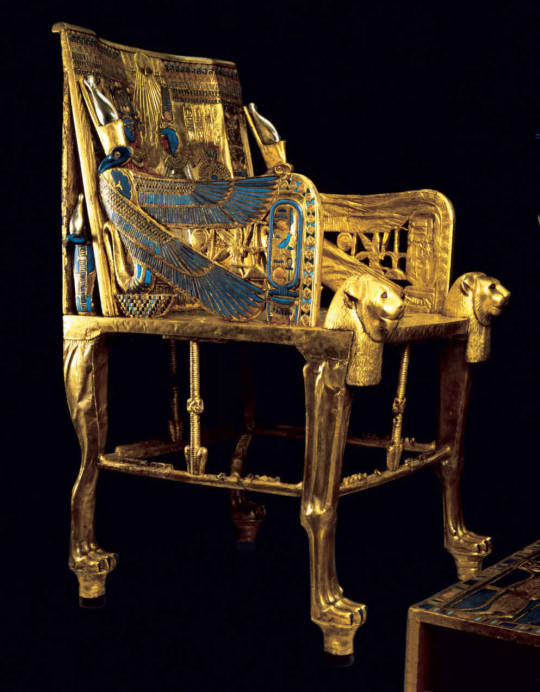

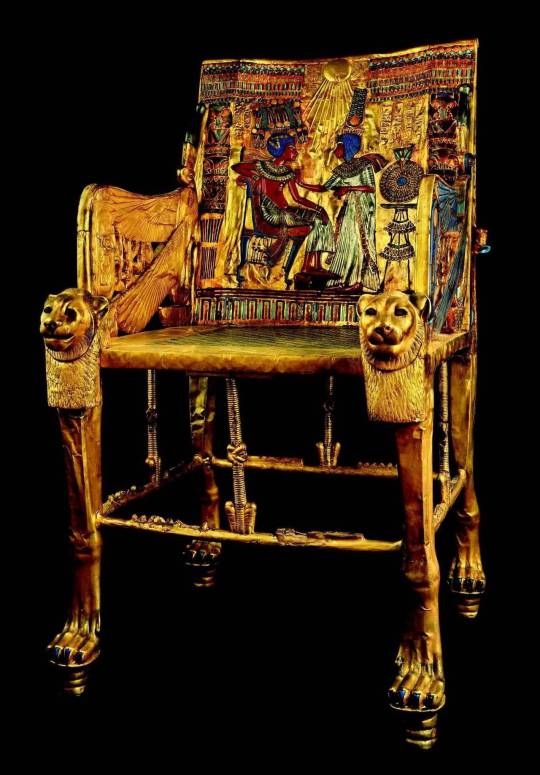

Golden Throne of Tutankhamun
New Kingdom, late 18th Dynasty, reign of Tutankhamun, ca. 1332-1323 BC.
The luxurious armchair is distinguished by the complexity of its technique and an abundance of details. Two projecting lions’ heads protect the seat of the throne while the arms take the form of winged uraei or rearing cobras wearing the double Pschent crown of Egypt and guarding the cartouche names of the king.
The golden throne of Tutankhamun was discovered in 1922 by the British archeologist Howard Carter. It was found beneath a hippopotamus funerary bed in the antechamber of the Tomb of Tutankhamun.
The throne is called (Ist) in Egyptian hieroglyphs after the name of the mother goddess Isis. who was usually depicted bearing a throne on her head as her characteristic emblem. It is made of wood and covered with gold and silver. It is ornamented with semi-precious stones and colored glass.
The throne meant, not only the link between the worlds of Gods and the people, but also majesty, stability, safety and balance. Since kings were considered Gods on earth, it may not be difficult to imagine Tutankhamun imposing his divine will over the rest of mortals while sitting on this golden throne.
Wood, gold leaf, silver, semi-precious stones, glass paste,
Height: 102 cm, Length: 54 cm, Width: 60 cm,
Egyptian Museum, Cairo.
#art#design#history#luxury lifestyle#style#furniture#throne#gold#tutankhamun#egypt#gold leaf#glass#wood#gods#egyptienmuseum#cairo#tomb#new kingdom#armchair
1K notes
·
View notes
Note
Hey, so you seem to be the the All Knowing in terms of twst. With Glorious Masquerade getting a rerun soon, I was looking at the cards.
So what the heck is up with Jamil's freaking hat? I'm sorry but I can't look at it without laughing. It looks so stupid. The closest thing I can think of that matches it is the combined crowns of upper and lower Egypt, but this is the equivalent of France so that can't be it.


While I’m flattered that people come to me with their questions, I want to take a moment to remind everyone that I’m just another TWST fan like you are! ^^ It’s stressful to be considered “all knowing” or a fandom authority 💦 That puts a lot of pressure on me to speak on certain subjects or to interact in a certain way (since people might put too much stock into what I say), and then that ends up detracting from my enjoyment. I’d rather not be put on such a high pedestal, please and thank you.
Now, onto the question!
According to Rollo in 1-13 of Glorious Masquerade, the costumes the NRC students were gifted are “patterned after designs that are over 500 years old.”
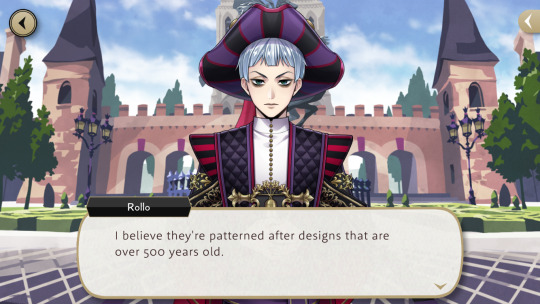
If we extrapolate this to real life, the implication is that these costumes have roots in Renaissance era (14th century to 17th century) French fashion. Interestingly, Rollo’s own hat is similar to a tricorne, which was primarily worn in the 18th century… so technically, his hat is more “modern” than what the NRC students wear 😂
So I browsed through records of hats from the indicated period and guess what? I couldn’t find an exact match—though I did find a lot of hat designs that I found way sillier than what the NRC boys have. Like… sorry, what is THAT 😭
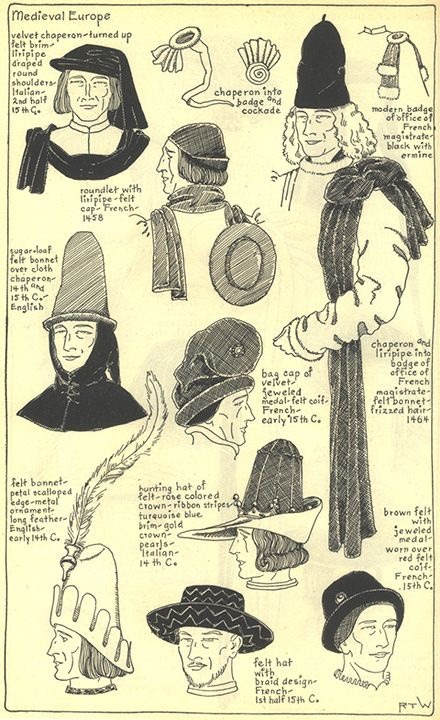
Some headwear which bears a vague similarity to Jamil’s hat are the Egyptian combined/double crown (the pschent), which Anon has already mentioned, and the French hood, which was worn by women in the 15th century.

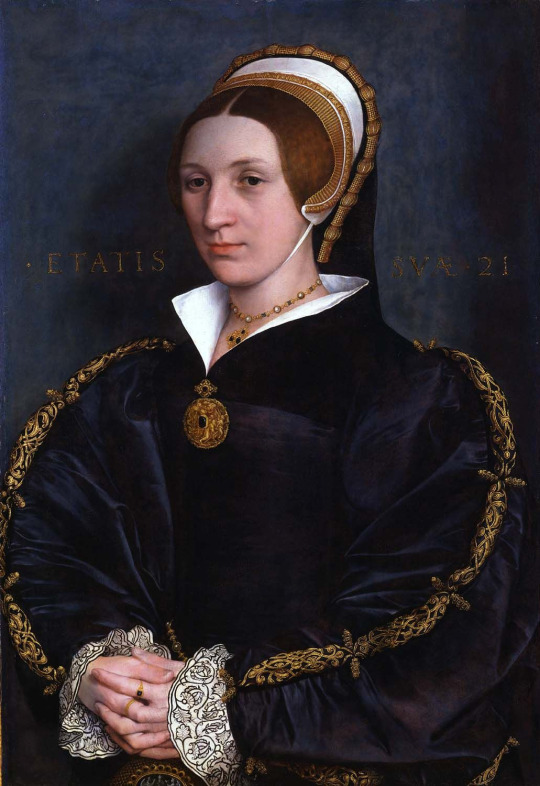
The actual closest match I came across was the mitre, a liturgical headdresses worn by Roman Catholic officials. If you look at it from the front, it doesn’t look like much, but it definitely has the height of Jamil’s hat. But then look closer and you’ll realize the mitre does not have one single flap of fabric, but rather two.

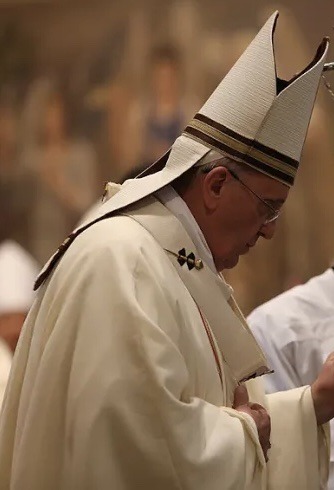
If you take the front flap of a mitre and fold it back, you would probably get something very similar to what Jamil wears. (Note that the black part of the hat is NOT his hair, but is fabric that is part of the hat.)
Considering that Noble Bell College is styled like a cathedral and that the Renaissance era from which the Masquerade Dress clothing derives is characterized by the rediscovery of classical literature, art, and philosophy… perhaps it’s not so strange to see a hat borne of religious associations.
… Why did Jamil specifically get this hat? Not sure, I’m not religious myself so don’t ask me to psychoanalyze him from that angle 😂
The golden part securing the front is unusual and does not appear in French fashion of the time (at least not from what I could tell?). It’s styled like pschent but more likely is meant to be turban-like due to Jamil’s inspiration, Jafar, having the same feather sticking up in the middle of a bulbous hat. You’ll notice Jamil had a “feather” too, albeit metal:
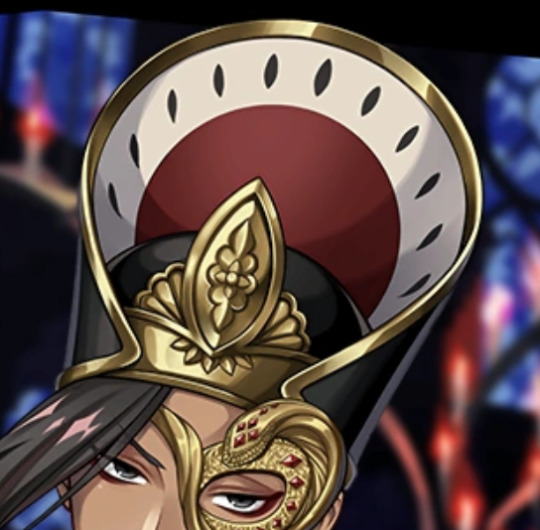
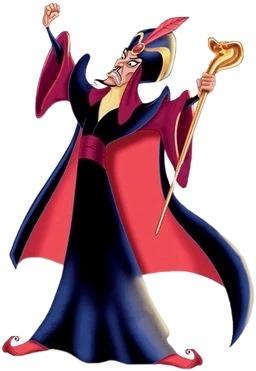
To summarize, I think the design of Masquerade Dress Jamil’s hat borrows from multiple inspirations and not just one/old French fashion. Yana has stated before in a March 2023 interview with the Apple App Store that the cultures of Twisted Wonderland are unique and that the clothing that appears in the game are not “reinterpretations of existing costumes”. She seems to incorporate elements from both high fashion and from a variety of cultures to arrive at the final designs. For example, there are elements of many Nordic cultures in the Apple Pom outfits, and the Pomefiore uniform has a Japanese kimono-like silhouette despite the dorm being based on the the Evil Queen (originating from a German tale). I assume something similar happened when designing the Masquerade Dresses; Yana and co. wanted to combine elements and make something of their own.
Final comment I'll make, the shape of Jamil's hat looks like a kind of dumpling... It makes me hungry.

#twisted wonderland#twst#Jamil Viper#Rollo Flamme#disney twisted wonderland#disney twst#notes from the writing raven#question#glorious masquerade spoilers#advice#evil queen#Jafar
102 notes
·
View notes
Text
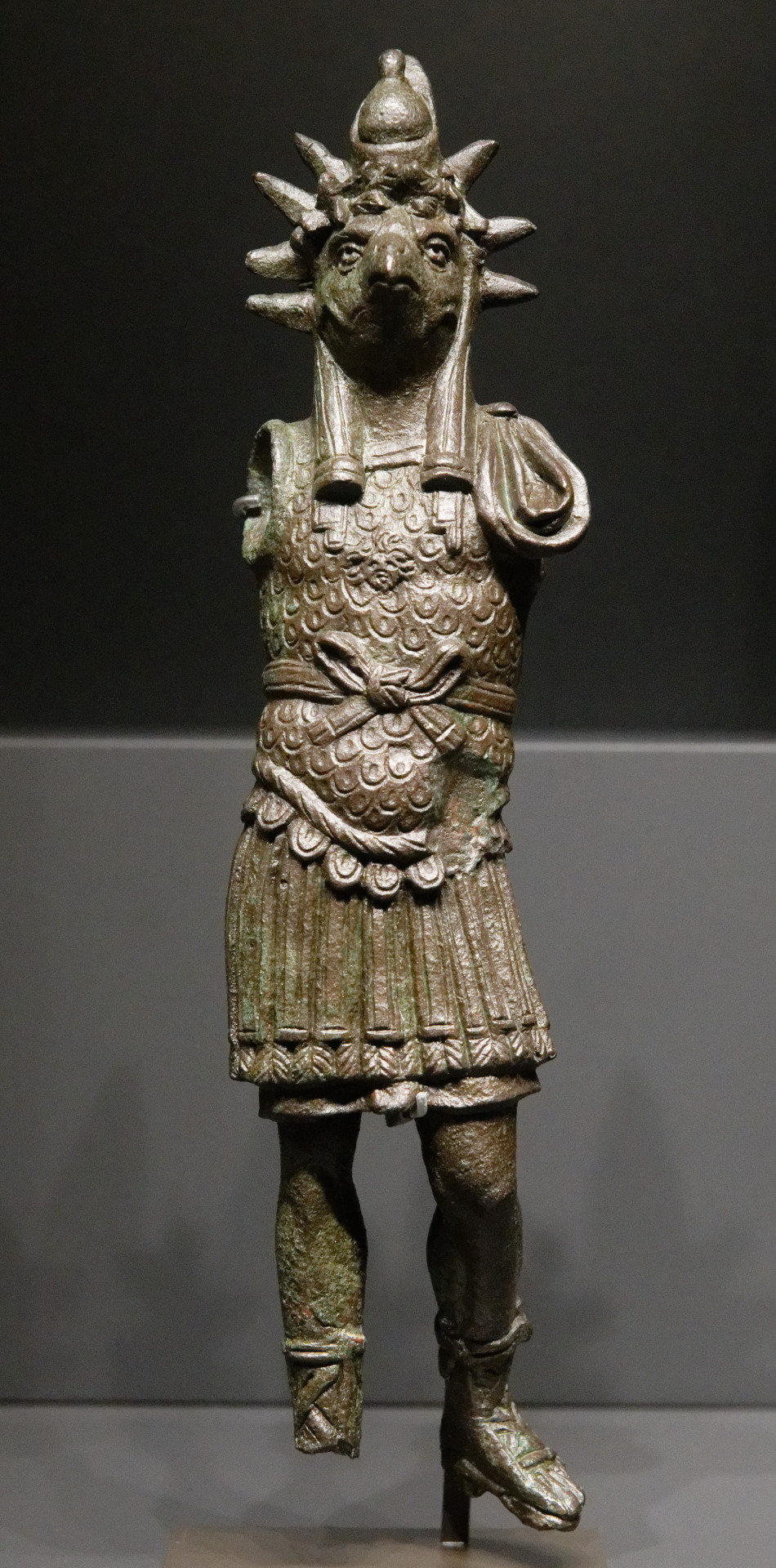
The Egyptian deity Horus as a Roman emperor. The figure bears the falcon-head of Horus, topped by the characteristic double crown (pschent) of Egyptian pharaohs, but also wears Roman armor (specifically lorica squamata, consisting of metal scales sewn to a fabric backing) with a small gorgoneion. Artist unknown; 2nd cent. CE. Now in the Louvre. Photo credit: © Marie-Lan Nguyen / Wikimedia Commons /
CC-BY 4.0
#classics#tagamemnon#Ancient Rome#Roman Empire#Egypt#Ancient Egypt#art#art history#ancient art#Egyptian art#Ancient Egyptian art#Roman art#Ancient Roman art#Roman Imperial art#Roman Egypt#Romano-Egyptian art#Horus#Egyptian religion#Ancient Egyptian religion#kemetic#syncretism#sculpture#statuette#figurine#metalwork#bronze#bronzework#Louvre#Louvre Museum#Musee du Louvre
1K notes
·
View notes
Text

Statue of Horemheb and Horus
In this nearly life-size statue made of white limestone, Horemheb is seated on the right side of Horus, who places his right arm around the king’s waist. The god’s left hand is holding the sign of life. The two figures greatly resemble each other.
Both have bare upper bodies and wear the shendyt kilt and the Pschent or double crown in ancient Egypt. The king is also wearing the striped royal nemes headdress and a false divine beard. On first inspection, the sculpture appears to be in a perfect state of preservation, but this is deceptive.
New Kingdom, late 18th Dynasty, reign of Horemheb, ca. 1319-1292 BC. Now in the Kunsthistorisches Museum, Vienna. Inv. 8301 Read more
379 notes
·
View notes
Text
Egypt. Ancient Egypt is Africa. BLACK Africa,
Throne fit for a king: Tutankhamun's regal chair, a testament to ancient Egyptian craftsmanship and the grandeur of pharaonic rule. 𓁈 The golden throne of Tutankhamun is a unique work of art. It is considered to be one of the most significant and well-preserved pieces of furniture from ancient Egypt. Its colours have not faded over three thousand years, which serves as a testament to the high skill of the ancient Egyptian craftsmen. The luxurious armchair is distinguished by the complexity of its technique and an abundance of details. Two projecting lions’ heads protect the seat of the throne while the arms take the form of winged uraei or rearing cobras wearing the double Pschent crown of Egypt and guarding the cartouche names of the king. The golden throne of Tutankhamun was discovered in 1922 by the British archaeologist Howard Carter. It was found beneath a hippopotamus funerary bed in the antechamber of the Tomb of Tutankhamun. The throne is called (Ist) in Egyptian hieroglyphs after the name of the mother goddess Isis, who was usually depicted bearing a throne on her head as her characteristic emblem. It is made of wood and covered with gold and silver. It is ornamented with semi-precious stones and coloured glass. The throne meant, not only the link between the worlds of Gods and the people, but also majesty, stability, safety and balance. Since kings were considered Gods on earth, it may not be difficult to imagine Tutankhamun imposing his divine will over the rest of mortals while sitting on this golden throne.
21 notes
·
View notes
Text

Ring of Ptolemy VI Philometer wearing the pschent, traditional double crown. Geek artwork 3 rd -2 nd century BC. #Louvre_Museum.
#egyptology #archeology #ancientegypt #egyptian #travel #ancient #egipto #egypte #cairo #history #archeology #thisisegypt #visitegypt #ancienthistory #egyptianart #egipt #luxor #egitto #archaeology #pyramids #alrexander_the_great #travelphotography #stater #egyptshots #madeinegypt #drachma #ancientegyptian #hieroglyphs #photography #Ptolemy_I #الصديق_الصدوق
#history#photography#archaeology#greek coins#culture#palestrina#roman coins#travel#sidon saida tyre beirut phoenician الصديق_الصدوق#الصديق_الصدوق#egyptology#Ptolemy_VI_Philometer
9 notes
·
View notes
Text

Heruakhety (Horakhty) is an Egyptian god whose name means "Horus of the Horizons." He is thus associated with the sun's crossings made each morning and evening. Horus is a particularly complex deity; he appears under a number of names and in a number of guises, most notably Horus the Elder (Heru-wer) and Horus the Younger (Heru-sa-Aset) but he has other significant aspects as well, including the form of Heruakhety. He was later associated with Ra and known as Ra-Heruakhety. Like Ra, he had a particular center of worship in the city of Heliopolis. He is depicted here as a man with the head of a hawk, wearing the solar disk with uraeus snake and the double crown (pschent) of Upper and Lower Egypt. He carries the was staff, a symbol of power, in one hand and the ankh, a symbol of life, in the other.
Heruakhety who crosses the sky with incense, great god of the horizon, I praise and honor you.
5 notes
·
View notes
Text
Crowns of Ancient Egypt
A brief overview of the different kinds of crowns seen in Ancient Egyptian iconography. Note that I say crown, note headdress; the well-known nemes headdress and similar things not worn by the king and gods will not be covered.
Hedjet: translates as “White One,” the crown of Upper Egypt. Most famously worn by Nekhbet, Horus, and Satet. Nekhbet, the Patroness of Upper Egypt, was occasionally placed on the brow of this crown as an ornamental vulture.
Deshret: translates as “Red One,” the crown of Lower Egypt. Most famously worn by Wadjet, Horus, and Neith. Like her sister, Wadjet- the Patroness of Lower Egypt- would commonly adorn the crown as a uraeus. However, this symbol was featured on a majority of the other crowns as well.
Atef: a hedjet crown with two ostrich feathers on opposite sides. Most commonly associated with Osiris and his followers, but was also worn by Underworld related deities like Sokar.
Hemhem: translates as “to shout,” “cry out.” This translation has led to speculation that it was associated with battle or military power. It’s three atef crowns placed side by side atop curled ram horns; sometimes there is a solar disc above each atef, sometimes just the middle one, sometimes not present. Not specifically associated with any one deity, but Khnum and Sobek are often depicted wearing one.
Pschent: also called sekhemty- translating as “the Two Powerful Ones”- it combines the hedjet and deshret to become the crown of a unified Egypt. Though the Pharaoh Menes is said to have first united the crowns, surviving records show Djet was the first to wear it. Horus is the deity most commonly associated with it, but Atum-Ra was also shown wearing the double crown at times. The Two Ladies Nekhbet and Wadjet would both adorn this crown side by side, further symbolizing the union of Upper and Lower Egypt.
Khepresh: known to exist in the second intermediate period, but popularized in the New Kingdom; worn by pharaohs for militaristic and possibly religious purposes. It isn’t associated with any deities, but as with most royal headdresses it often featured a uraeus.
Cap Crown: one of the oldest crowns of Egypt recovered by Egyptologists, depictions of it stretch as far back as the Old Kingdom. Again, no particular deity is associated with it, seemingly exclusive to the human Pharaoh, but it did almost always feature a uraeus.
Solar Crown: also called a solar disc, this was used to not only signify a solar deity but royalty. It’s most commonly associated with Ra, but many other deities have worn one, even if only in rare depictions. Most commonly, the solar crown is also worn by deities like Horus-Ur (Horus the Elder), Isis, Hathor-Sekhmet, Amun, Tefnut, Bast.
Lunar Crown: like the solar crown, this can also be alternatively described as a lunar disc. Unlike its counterpart, however, it was rarely described with a single phrase despite being not uncommon in depictions. The closest it had to its own word was shared with the moon in general. The crown itself was depicted with the full moon resting in the curve of an upturned crescent moon. Deities like Khonsu and Thoth are most associated with this crown, but Tefnut and Mehit also wore it occasionally.
Two-Feathers Crown: also called the Amun crown as it was most commonly associated with him, but it is also worn by Montu and Min. Unlike the atef, these feathers are described as those of a falcon rather than an ostrich- but similar to the hemhem, they’re placed atop two ram horns and sometimes feature a solar disc.
7 notes
·
View notes
Photo





A RWBY weapon I have been tinkering with for an OC.
Deshret & Hedjet - the red & white crowns of the old kingdoms in Egypt; when combined they create Pschent - The Double Crown.
The individual blades loose fire and wind blasts respectively, while when combined into a dual bladed sword they can create a whirlwind of flame or act as a bow.
The texturing was done by https://twitter.com/Valoroth whom I heartily recommend.
Transformations
youtube
24 notes
·
View notes
Photo

Counterpoise with Horus in the Marshes 📸 1. Horus 𓅄 “ḥrw” wearing the double crown of Egypt - Peshent 𓌂𓐍𓏏𓋖 “sḫm.ty” ‘The Two Powerful Ones’ (Double Crown) standing in a palace (kinship) and in serround by papyrus plants 𓇅𓏤𓆰 “w3ḏ” from the marshes 𓋴𓐍𓏏𓇏𓈅 “sḫ.t” of the Delta of Lower Egypt/North 𓇾𓇊 “t3-mḥw” from where he was born 𓄟𓋴𓁒 “ms”. 📸 2. Aset 𓊨𓏏𓆇 “3s.t” is breastfeeding 𓋴𓃀𓈖𓏏𓀔𓁐 “sbn.t” the child Horus. She is standing and wearing a tripartite wig of vulture motif representing the goddess Mut 𓏏𓅑𓁐 “mwt” and with disked horns of the goddess Hathor 𓉡 “ḥw.t-ḥr” ‘The Temple of Horus’ l. She is breastfeeding Harpocrate (the child Horus) who is standing naked 𓇇𓄿𓇌𓋳 “ḥ3y” and wears the pschent crown and holds the ankh 𓋹𓈖𓐍 “ˁnḫ” (symbol for life). A chapel of papyriform columns, from the hathoric capital, serround the pair. 📸 @museelouvre 𓋹𓎬𓋹𓎬𓋹𓎬𓋹𓎬𓋹𓎬𓋹𓎬𓋹𓎬𓋹𓎬𓋹𓎬𓋹𓎬𓋹𓎬𓋹𓎬𓋹𓎬𓋹𓎬𓋹𓎬𓋹𓎬 @egyptologylessons 𓋹𓊽𓋴𓆖𓎛𓇳𓎛 © 𓊁𓊁𓊁𓊁𓊁𓊁𓊁𓊁𓊁𓊁𓊁𓊁𓊁𓊁𓊁𓊁𓊁 #Ancientegypt #ägypten #egyptology #egypte #egitto #egipto #이집트 #horus #counterpoise #egyptianjewelry #aset #marshes #mythology https://www.instagram.com/p/CnuYMAFuQVQ/?igshid=NGJjMDIxMWI=
#ancientegypt#ägypten#egyptology#egypte#egitto#egipto#이집트#horus#counterpoise#egyptianjewelry#aset#marshes#mythology
18 notes
·
View notes
Text
anonymous | Misc. Asks
O' wise and powerful Djehuty, please impart upon this fool what great meanings the colors had in old Kemet orz


"While I most certainly glory in such reverent praise as much as the next god, the question you ask is of no great secrecy. Your approach is comparable to groveling on one's hands and knees to know the time of day. Quite humorous, but it reflects poorly on you."
[ readmore cus Lots Of Words ]
"The Kemetic word for color- 'iwn'- can also be translated as disposition, nature, or character, attesting to its innate link with the essence of existence. As such, every color has a spectrum of qualities associated with it, some more heavily than others- but this does not erase the variety of connotations they may have in their different hues. The traditional palette includes six main groups of iwn- white, black, red, green, blue, and yellow."
"White, or hedj- sometimes shesep- signifies ideals like joy, peace, and wisdom. It also depicts radiance, divine grace, and cosmic light. As such, it was often used in the garb of priests and the royal family. The crown of Upper Egypt was white, Lower Egypt red- when they combined as the Pschent, it ushered in the unification of Kemet, leading the color combination to signify completeness. Many instruments key to the ritual of mummification were carved from white alabaster. Silver is still more radiant than white, though they share the same word in regards to the color. This precious metal is associated with Lord Nefertem's lotus, as well as the moon. Subsequently, it is closely tied to Khonshu and myself."
"Black is kem- 'Kemet' translates to 'Black Land,' the kingdom named so for the banks of the Nile. Black is the color of fertile soil and rain clouds. It is a reminder that all life comes from the earth, and all life will return to it. Black is death- but also rebirth and fertility. Anubis is most often depicted in this color for a reason. Kem is, at times, also indicative of chaos, darkness, night, and foreigners. Though it can control chaos as well, if you know how to direct it."
"Red- deshr- is similarly complex and varied in meaning. It can be used to signify the harsh sand of the desert, ravenous fire, blind rage, destruction, war, chaos- Indeed, the English word 'desert' is derived from 'dshrt,' meaning the Red Place. However, it is also indicative of the Pharaoh's power and strength, the sun's radiance, and the very blood that flows through humanity's veins. It's most closely associated with the wicked Set, and thus highly vilified- but both Lords Ra and Amun are associated with red as well. Ladies Sekhmet, Bast, Tefnut, and Mafdet are all closely connected to the color, the red glow of the Eye of Ra and the sun's protective power. Lady Isis' Tjet was crafted from red jasper, as have every holy recreation after it. Masculine figures were depicted as reddish brown- demy being the name of the specific hue- signifying the tanning of their skin as a result of their outdoor duties."
"Often erroneously stated as deshr's opposite, green- wadj- is peace, harmony, life sustaining vegetation. However, as the cycle of life is innate in all matters therein, deshr is also death, resurrection, and the afterlife. Lord Osiris' skin was tinged green upon his rebirth, many depictions exacerbating this feature in much the same way they do Set's red features. The stone malachite- representative of joyfulness, and sacred to Lady Hathor among others- and the papyrus plant are present in the hieroglyph for wadj."
"Blue- irtyu- holds many meanings of great importance. It is vital within spirituality, featuring in tomb paintings and adorning temple ceilings. It represents the divine aspect of being. Of existing. Lord Amun, the very first netjer, is often depicted with blue skin- as is the creator Nu, from which everything originated. Blue is water; not only life, but origin, fluidity, infinity. It is also the sky, the heavens, the vast universe. It is magic. Lady Ma'at's robes are blue for its cosmic qualities. We netjer were depicted at times with hair like precious lapis lazuli, or 'khesbedj.' I, myself, have a close association with irtyu as well. It is heavily associated with order on account of Lady Ma'at- but let it be remembered that the same calm, hydrating waters can become destructive floods and hold suffocating depths."
"Yellow- khenet or kenit- represents that which is eternal and indestructible; the Pharaoh, his power, his kingdom. A lighter shade of kenit was used for the skin of women and powerful officials, as they remained indoors most of the time. Impossibly still more perdurable than kenit is nebu- gold. It is the rays of the sun, the influence of Lord Ra himself, and godly power. It was belied we netjer had skin made of nebu, and bones of hedj- While I can assure this is not precisely the case, the precious metals are nevertheless closely associated with the gods. When depicted in paintings, gold is used for the netjer."
"Ah- I really could go on about color in beloved Kemet's beliefs and culture, but you mortals do not have the time to spare. Not in this life, at least. The condensed summaries will have to suffice."
#They're Listening... : asks#(Another) Unknown Entity : anonymous#Scribe of the Gods : Thoth#[ Thoth and I both vibrating with Color Symbology Infodump ]
2 notes
·
View notes
Text
iusa don’t forgive & chew acacia bubblegum with all if not none thee cruel Melech & Mongul who Pharaohs & Caesars bless themselves to know The Triquetra put them on the throne & gave them the laurel & Pschent crown
0 notes
Text

Pectoral of King Shoshenq II
At its top, this pectoral King Shoshenq II displays two falcons, each wearing the Double Pschent Crown of Upper and Lower Egypt. They are sitting upon the hieroglyphic symbol for sky, which is adorned with stars.
To either side is a goddess, each stretching her wings out in protection: to the left is Hathor, while to the right is Maat. Plants, symbolizing Upper and Lower Egypt, stand behind each. Water can be seen below the boat, represented by inlaid wavy lines. At the bottom are alternating open and closed lotuses, although the final lotus to the left is missing.
Third Intermediate Period, 22nd Dynasty, reign of Shoshenq II, c. 887-885 B.C. Now in the Egyptian Museum, Cairo. JE 72171 Read more
66 notes
·
View notes
Text
My #hanpainted #mannequin Pharaoh Amenhotep III, with the #pschent which is the crown of Lower and Upper Egypt. For sale at Art of Poland Gallery #kamaarts #kamilawojciechowiczkrauze #pharaoh #ancientegypt
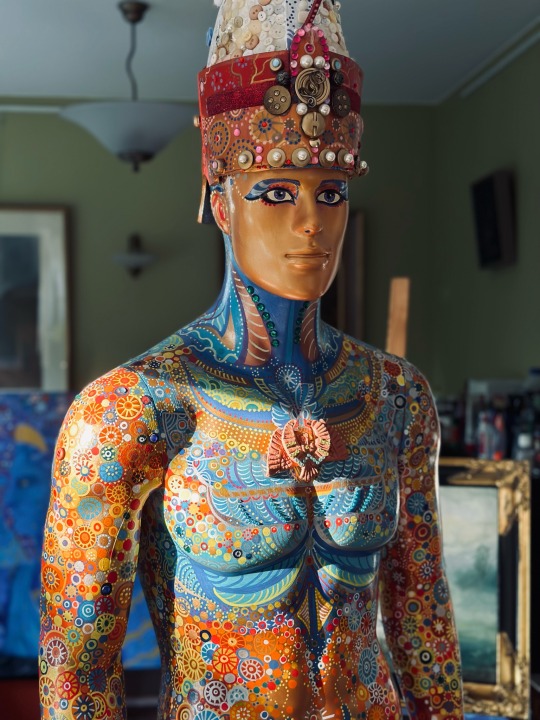
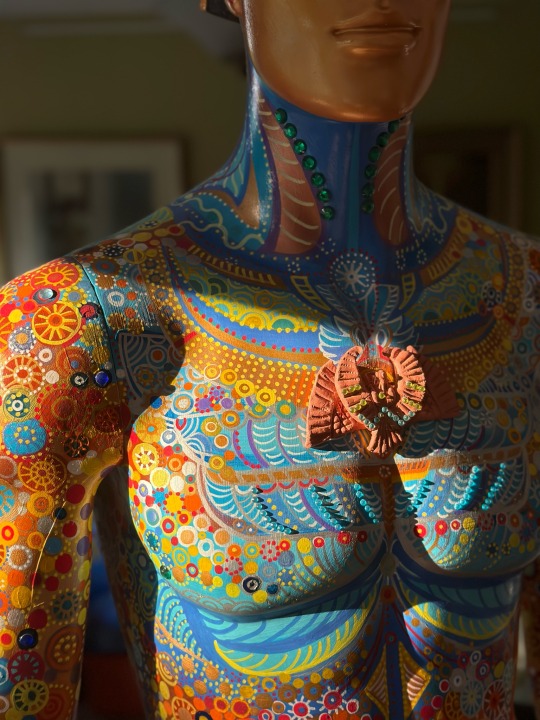
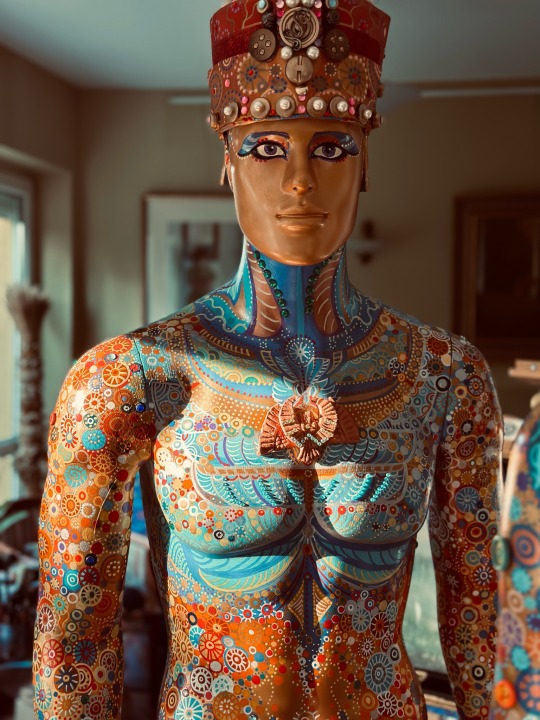
#kamaarts#kamilawojciechowicz#kamila wojciechowicz-krauze#warszawa#warsaw#polish artist#art of Poland#gallery#amenhotep iii#pharaoh#ancient Egypt#art for sale
1 note
·
View note
Text
Hi!
Hellow! So, my first Post here on Tumblr, i am Bad at this! But as Apology, take a smol History Fact!
Did you knew that the Egyptian Kingdom was originaly 2 Parts? Upper and Lower Egypt, and both Kingdoms had a different Crown! Upper Egypt had a White Crown, the "Hedjet" while Lower Egypt had a Red Crown, the "Deshret".
The Pharao that United both Kingdoms wore a Combination of both, named the "Pschent", a Double Crown in Red and White!
The more you know! I hope you welcome me here!

1 note
·
View note
Photo



1. Pschent Crown by Seven Phillips 2. Blind Man’s Bluff by Adolph Menzel 3. 𝒫𝒽𝒶𝓇𝒶𝑜𝒽 𝓌𝒶𝓈 a𝓈𝓉𝓇𝑜𝓃𝒶𝓊𝓉 by winteagle (vid)
When in ancient Egyptian times souls were raised into the higher worlds through the Hermes Initiation, then — as it must always be after Initiation — they felt themselves to be outside their physical and etheric bodies and knew that they were now within a world of spiritual facts and spiritual beings. Wide was the circuit of vision through which these souls were then led. They were shown the individual beings and facts, as can happen also with the soul of today. But one must not think of it as though they went about on physical feet; it was their vision that was guided, as if a person's sight were to be led all round a region as wide as the universe. Thus it was in this Initiation. … How did that reappear which had become submerged in ancient Egypt? It reappeared in such a way that it became visible in the Holy Vessel which is spoken of as the “Holy Grail”, guarded by the Knights of the Holy Grail. In the rise of the Holy Grail can be found that which had sunk down in ancient Egypt, and in this arising of the Holy Grail there stands before us everything that went into the post-Christian renewal of the principle of the ancient Mysteries. Fundamentally speaking, the phrase the “Holy Grail”, with all that belongs to it, involves a reappearing of the essence of the Eastern Mysteries.
—Rudolf Steiner, The Mysteries of the East & of Christianity: Lecture V–IV
#Seven Phillips#adolph menzel#winteagle#Anthroposophy#spiritual science#Pharaoh#Grail Knights#the holy grail
0 notes